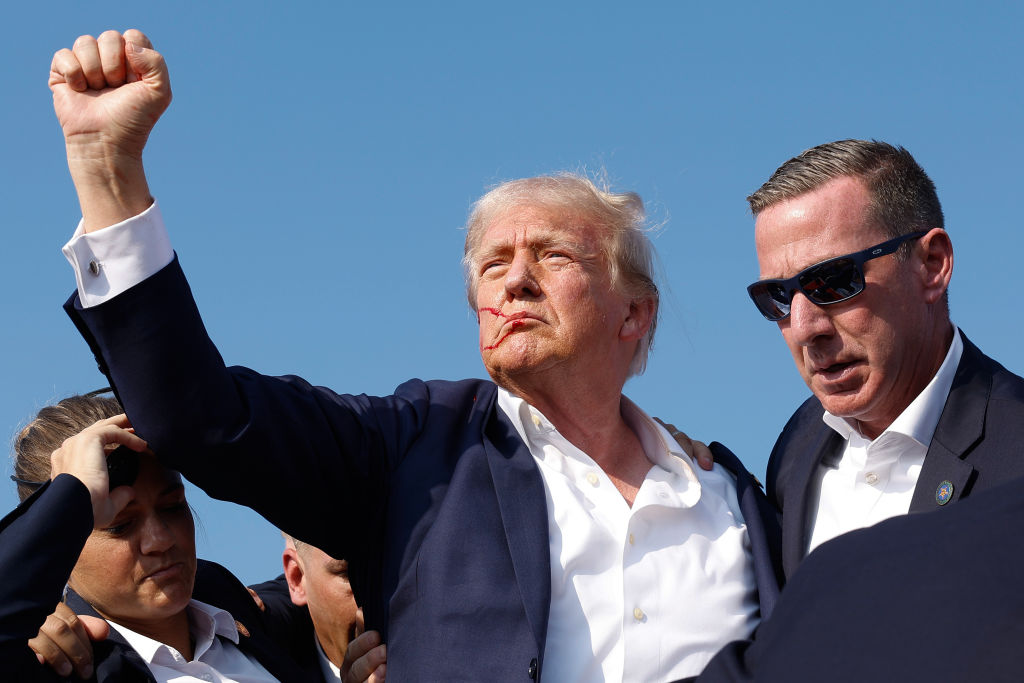Trump’s near-death experience gives him a second chance.
All Too Real

To a growing crowd of irrationalists, the attempted assassination of Donald Trump is just another conspiracy theory.
The horrible assassination attempt on the life of Donald Trump at a rally outside Pittsburgh wounded but failed to kill the former president, though one other person was killed and two are in critical condition. The event marks the darkest descent yet in America’s toxic politics, the kind of horror that shocks when it happens but on reflection seems entirely foreseeable. We have been traveling a dangerous road for years. The killed and injured spectators were not as fortunate as Trump himself, who seems to have dodged death by inches.
Many questions demand answers. How could the Secret Service permit a gunman to occupy a rooftop with a direct line of sight to the podium where Trump would stand? Were the urgent warnings of a witness ignored? Are Trump’s rallies adequately secured?
One question that most of us probably don’t consider asking is: Did the event happen at all? Immediately after the shooting, however, the lower depths of social media—populated by thousands of pseudonymous accounts that boast hundreds of thousands of followers and significant reach—were flooded with assertions that the shooting was “staged,” and that Trump wasn’t injured. Doubters instantly asserted that the whole thing was faked.
“It’s been eight years, eight years, and this is the first time anybody’s…? Nah,” said L.C. Kent, a TikTok content creator with 110,000 followers. “This feels like such a false flag.” Jess Margera, a rock musician and brother of the famed skateboarder Bam Margera, posted on X, “I await more details but this seems really convenient to happen right now after the world just woke up to project 2025. It’s just fishy as fuck.” Actress Amanda Seales, known for her role on the acclaimed HBO comedy Insecure, said, “That shit was more staged than a Tyler Perry production of Madea Runs for President.” Seales elaborated, explaining that she had “lived in Harlem long enough to know that gunshots do not sound like making popcorn on the stove.”
The purveyors of this particular idea are, admittedly, neither credible commentators nor well-informed observers. But they represent a bold and common feature of American life right now, best described as a kind of naïve incredulity, or an adamant refusal to be fooled by appearances, because there must always be more to the story.
This is an easy trap for anyone, not just C-list actors or singers, to fall into. The reasoning behind the tendency goes like this: because the world is awash in lies and intrigues, it follows that everything is necessarily a conspiracy. You would have to be an idiot to believe the surface of any story. People easily get drunk on the power of what we might call total critique, as we see among pro-Hamas, “anti-colonialist” protesters who have turned every Western value and sense of national identity on its head, or as Marx suggested, on its feet.
Noted commentator Candace Owens constantly demonstrates this sophomoric, terminal skepticism. Recently she made news when she launched a defense of Josef Mengele, the Nazi camp doctor at Auschwitz. Mengele used his position and ready supply of laboratory material to satisfy his fascination with genetics by experimenting on prisoners, especially twins and people with eyes of different color. It is uncontroversial and widely documented that Mengele conducted experiments that tortured and murdered people, including children, but according to Candace Owens, we are all victims of a narrative that falls apart upon close inspection. The idea that Mengele would operate unnecessarily on healthy people is “bizarre propaganda,” says Owens, because it would have been “a tremendous waste of time and supplies” in wartime.
This is the same argument that Holocaust deniers always make—namely, that it would have been absurd for Nazi Germany to build and staff extermination camps and use valuable fuel to transport prisoners and burn their bodies when the war effort demanded economizing of the strictest sort. But this argument-from-rationalism, while observing the law of logical parsimony, ignores the fact that political ideology, especially of the collectivist sort, can veer into insanity while preserving a face of calm deliberation. Owens smugly displays her resistance to the dominant narrative while she marches in circles around a hole of error she has worn with her own feet.
Skepticism is great, and we don’t get enough of it. But skepsis without constant reality checks is just solipsism. The use of “rabbit hole” to describe tunneling through Wikipedia in search of dizzying counter-narratives is apt, but warren-voyagers and mainliners of critique often forget that theirs is less a search for truth than a step into the epistemological void, exchanging one false truth for another.
Poke around and you will find this sort of thing on the rise. Half of Gen Zers don’t believe NASA landed on the moon, though they also appear unaware that NASA must have faked a total of six crewed moon landings, as well as the aborted Apollo 13 mission. (Why fake a near-disaster, one wonders.) Many young people refuse to accept that Helen Keller learned to read and write, though deafblind literacy is common, as a casual investigation would reveal. In both cases, skepticism about established facts is driven by a refusal to be fooled that is ultimately more foolish and stubborn than anything.
It’s not just young and callow Google addicts who incline toward this conspiratorial tendency. Look at the events of the last few years, when many of the best and brightest minds insisted that Trump was a Russian spy, and that locking down society and forcing small children to wear N-95 masks was the scientific way to handle a virus that mostly killed people in their late eighties or nineties. They chortled at the dupes who thought that horse medicine would treat the symptoms of a viral infection, though it was later proven to work, and was in fact already known to work. Now they beggar reason to imagine staging a live-fire exercise involving the murder and grievous wounding of spectators, as well as the death of the killer, in order to give Trump an opportunity to pretend that he was shot in the ear, using a “squib” or Hollywood blood bag to create the appearance of injury.
“Healthy skepticism” about broad public claims is always necessary. But our culture is gripped by a tic of reaching for exotic interpretation when what’s in front of our noses is self-explanatory. When Donald Trump is shot on live television, it makes sense to ask why and how it happened. That’s the leading topic of the day, as it should be. But to dispute that it happened is stupid and poisonous to our national health. We must restore, if not false confidence that our leaders always mean the best for us, at least a sense of confidence in the power of radical skepticism—sanity-checked by reference to the real world.
The American Mind presents a range of perspectives. Views are writers’ own and do not necessarily represent those of The Claremont Institute.
The American Mind is a publication of the Claremont Institute, a non-profit 501(c)(3) organization, dedicated to restoring the principles of the American Founding to their rightful, preeminent authority in our national life. Interested in supporting our work? Gifts to the Claremont Institute are tax-deductible.
Donald Trump and America each dodged a bullet.
Trump’s defense of the self-evident truths of our Founding should give way to a Lincolnian reconciliation.
Under the Left’s doctrine of stochastic terrorism, the culprits for the assassination attempt range far and wide.
Now is the time to challenge anti-American extremism.





